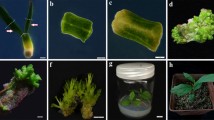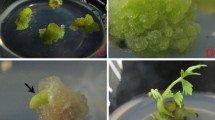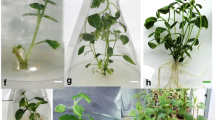Abstract
We have used apical meristem culture to develop an efficient protocol for reducing phytoplasma infection of Artemisia roxburghiana Besser var. purpurascens (Jacq.) Hook. plants. Shoot tips of different sizes from phytoplasma-infected field-grown plants were treated with 0.1% mercuric chloride (HgCl2) for 1 min followed by a 30-s exposure to 70% ethanol. The size of the explants significantly influenced the survival frequency and the success of aseptic culture establishment. Sterile explants responded notably to 13.95 μM Kinetin (Kn) and 0.27 μM α-naphthalene acetic acid (NAA), and a maximum of 38 ± 0.87 shoots per explant could be obtained after 6 weeks of incubation. Sub-culturing of the shoot mass after 8 weeks of culture on the previously described medium to 8.88 μM 6-benzyladenine (BA)- and 0.27 μM NAA-containing medium stimulated further multiplication, elongation and growth of each individual regenerant. Efficient rooting was noted after 5 weeks of transfer on half-strength MS medium containing 4.93 μM IBA. Sequential hardening as hydroponic cultures under culture room and glasshouse conditions led to almost 85 and 98% survival of the regenerants upon transfer to pots and field, respectively. Unlike the original A. roxburghiana plants, the plants raised from tissue culture showed a total absence of inherent phytoplasma infection evaluated via inspection of morphological features, PCR and microscopic observations.



Similar content being viewed by others
Abbreviations
- BA:
-
6-benzyladenine
- CTAB:
-
Cetyltrimethylammonium bromide
- EDTA:
-
Ethylene diamine tetra acetic acid
- IBA:
-
Indole-3-butyric acid
- Kn:
-
Kinetin
- MgCl2 :
-
Magnesium chloride
- MS:
-
Murashige-Skoog medium
- MQ water:
-
Milli-Q water
- NAA:
-
α-naphthalene acetic acid
- NaCl:
-
Sodium chloride
- PCR:
-
Polymerase chain reaction
- PVP:
-
Polyvinylpyrrolidone
- TDZ:
-
Thidiazuron [N-phenyl-Ń -(1,2,3-thidiazol-5-yl) urea]
References
Barlass M, Skena KGM, Woodham RC, Karke LR (1982) Regeneration of virus-free grapevines using in vitro apical culture. Ann App Biol 101:291–295
Benjamin BD, Sipahimaalani AT, Heble MR (1990) Tissue culture of Artemisia pallens: organogenesis, terpenoid production. Plant Cell Tiss Org Cult 21:159–164
Bicchi C, Rubiolo P, Marschall H, Weyerstahl P, Laurent R (1998) Constituents of Artemisia roxburghiana Besser essential oil. Flavour Fragr J 13:40–46
Dale PJ, Cheyne VA (1993) The elimination of clover diseases by shoot tip culture. Ann App Biol 123:25–32
Deng S, Hiruki C (1991) Amplification of 16S rRNA genes from culturable and non-culturable mollicutes. J Microbiol Methods 14:53–61
Dolinšek JA, Camloh M, Žel J, Kovač M, Ravnikar M, Carraro L, Petrovič N (2008) Phytoplasma infection may affect morphology, regeneration and pyrethrin content in pyrethrum shoot culture. Sci Hortic 116:213–218
Faggioli F, Martino L, Barba M (1997) In vitro micrografting of Pyrus communis shoot tips. Adv Hort Sci 11:25–29
Ferreira JFS, Janick J (1996) Roots as an enhancing factor for the production of artemisinin in shoot cultures of Artemisia annua. Plant Cell Tiss Org Cult 44:211–217
Fulzele DP, Sipahimaalani AT, Heble MR (1991) Tissue culture of Artemisia annua: organogenesis and Artemisinin production. Phytother Res 5:149–153
Gautheret R, Leddet C, Paupardin C (1984) Genetique, selection, multiplication. I Sur l’amelioration de genepis (Artemisia umbelliformis et A. genipi) par culture de meristems. Centro Rec Acad Agr De France 70:1237–1246
Gundersen DE, Lee IM (1996) Ultrasensitive detection of phytoplasma by nested PCR assays using two universal primer pairs. Phytopath Medit 35:144–151
Haider F, Bagchi GD (2005) Genus Artemisia: a treasure of bioactive molecules. In: Proceedings of second national interactive meeting on medicinal and aromatic plants (NIMMAP-2004), pp 62–81
Haider F, Kumar N, Banerjee S, Naqvi AA, Bagchi GD (2009) Effect of altitude on the essential oil constituents of Artemisia roxburghiana Besser var. purpurascens (Jacq.) Hook. J Essential Oil Res 21:303–304
Jain SK (1991) Dictionary of Indian folk medicine and ethno botany. Deep, New Delhi, pp 27–28
Khan MR, Raced H, Carwash A (2002) Development of aseptic protocols in olive (Olea europal L.) Cv. Pantaloon. Asian J Plant Sci 1:220–221
Lane WD (1978) Regeneration of apple plant from shoot meristem tips. Plant Sci Lett 13:281–285
Lee IM, Davies RE, Gundersen RE (2000) Phytoplasma: phytopathogenic mollicutes. Annu Rev Microbiol 54:221–255
Li H, Murch SJ, Saxena PK (2000) Thidiazuron-induced de novo shoot organogenesis on seedlings, etiolated hypocotyls and stem segments of Huang-qin. Plant Cell Tiss Org Cult 62:169–173
Liu CZ, Murch SJ, El-Demerdash M, Saxena PK (2003) Regeneration of the Egyptian medicinal plant Artemisia judaica L. Plant Cell Rep 21:525–530
Mackay WA, Kitto SL (1987) Rapid propagation of French tarragon using in vitro techniques. Acta Hort 208:251–257
Mackay WA, Kitto SL (1988) Factors affecting in vitro shoot proliferation of French tarragon. Hort Sci 113:282–287
Martino L, Cuozzo L, Brunori A (1999) Establishment of meristem tip culture from field grown olive (Olea europal L.) Cv. Moraiolo. Agric Med 129:193–198
Mathe A, Laszloffy K (1991) Data to the in vitro morphogenesis of Artemisia annua L. Acta Hort 300:293–299
Morel GM (1960) Producing virus-free Cymbidiums. Am Orch Soc Bull 29:495–497
Murashige T, Skoog F (1962) A revised medium for rapid growth and bioassays with tobacco tissue cultures. Physiol Plant 15:473–479
Nin S, Schiff S, Bennici A, Magherini R (1994) In vitro propagation of Artemisia absinthium L. Adv Hort Sci 8:145–147
Nin S, Morosi E, Schiff S, Bennici A (1996) Callus cultures of Artemisia absinthium L.: initiation, growth optimization and organogenesis. Plant Cell Tiss Org Cult 45:67–72
Pace L, Pacioni G, Spano L (2004) In vitro propagation of Artemisia petrosa ssp. eriantha: potential for the preservation of an endangered species. Plant Biosyst 138:291–294
Paniego NB, Giulietti AM (1994) Artemisia annua L.: dedifferentiated and differentiated cultures. Plant Cell Tiss Org Cult 36:163–168
Panse VG, Sukhatme PV (2000) Statistical methods for agricultural workers. Publication and information Division of ICAR, New Delhi
Quak F (1977) Meristem culture and virus-free plants. In: Reinert J, Bajaj YPS (eds) Applied and fundamental aspects of plant cell, tissue and organ culture. Springer, Berlin, pp 598–615
Samad A, Shasany AK, Gupta S, Ajayakumar PV, Darokar MP, Khanuja SPS (2006) First report of a 16SrVI group Phytoplasma associated with witches broom disease on Withania somnifera. Plant Dis 90:248
Sujatha G, Kumari BDR (2007) High frequency shoot multiplication in Artemisia vulgaris L. using thidiazuron. Plant Biotechnol Rep 1:149–154
Teixeira da Silva JA (2003) Anthemideae: advances in tissue culture, genetics and transgenic biotechnology. Afr J Biotechnol 2:547–556
Teixeira da Silva JA (2004) Mining the essential oils of the Anthemideae. Afr J Biotechnol 3:706–720
Whipkey A, Simon JE, Charles DJ, Janick J (1992) In vitro production of artemisinin from Artemisia annua L. J Herbs Spices Med Plants 1:15–25
Woerdenbag HJ, Luers JFJ, Van Uden W, Pras N, Malingre TM, Alfermann AW (1993) Production of the new antimalarial drug artemisinin in shoot cultures of Artemisia annua L. Plant Cell Tiss Org Cult 32:247–257
Acknowledgments
The authors are grateful to the Director, CIMAP (CSIR), Lucknow for providing the research facilities. Sincere thanks are also due to the members of the Photography Division for their co-operation and support.
Author information
Authors and Affiliations
Corresponding author
Rights and permissions
About this article
Cite this article
Banerjee, S., Haider, F., Bagchi, G.D. et al. Regeneration of phytoplasma-free Artemisia roxburghiana Besser var. purpurascens (Jacq.) Hook. plants using apical meristem culture. Plant Cell Tiss Organ Cult 103, 189–196 (2010). https://doi.org/10.1007/s11240-010-9766-9
Received:
Accepted:
Published:
Issue Date:
DOI: https://doi.org/10.1007/s11240-010-9766-9




